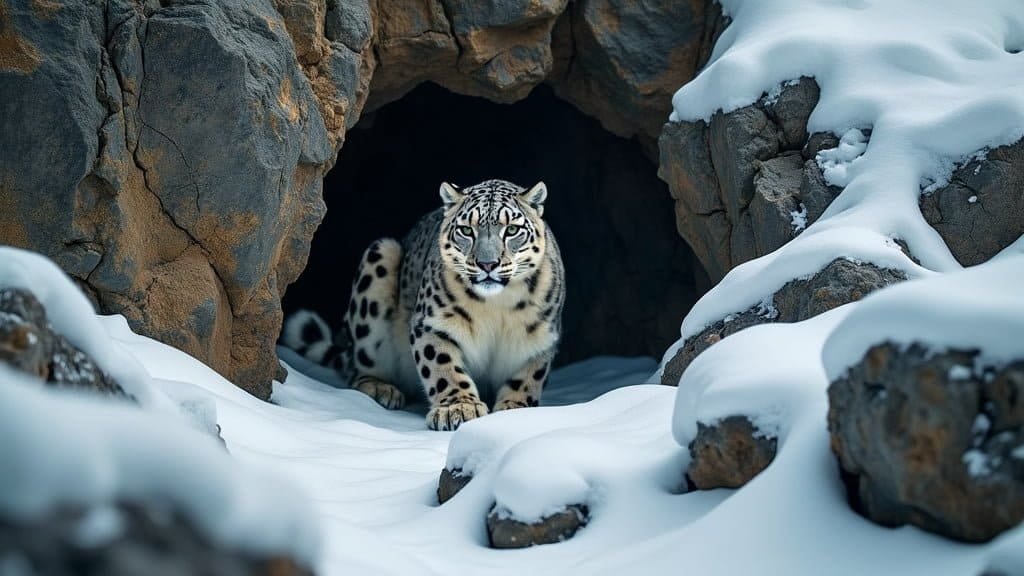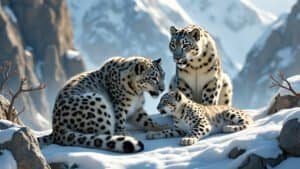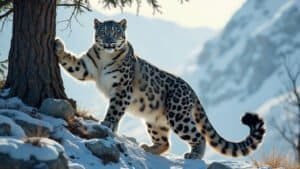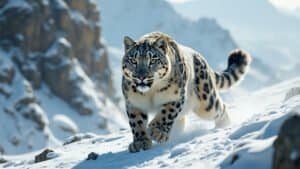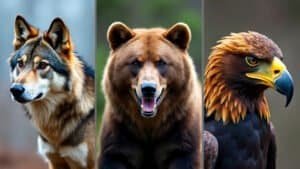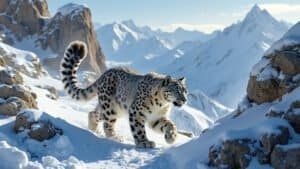Introduction
Snow leopards are elusive and majestic creatures that inhabit some of the most rugged and remote mountain ranges in the world. Choosing the right den is a critical part of their survival, especially when it comes to protecting their young from predators and harsh environmental conditions
In this article, we will explore the various factors that influence how snow leopards select their dens, their habits and patterns when it comes to den usage, and the types of shelters they prefer. By understanding these aspects, we gain deeper insights into the lives of these fascinating big cats
Factors Influencing Snow Leopard Den Choice
Snow leopards are solitary, territorial animals that require carefully selected dens for resting and raising their cubs
The choice of a den is not random but influenced by several critical factors. These factors include the terrain and seclusion of the location, safety from predators, and climate considerations
Terrain and Seclusion
Snow leopards inhabit some of the most challenging terrains on the planet, primarily in the mountain ranges of Central and South Asia, such as the Himalayas, the Altai Mountains, and the Tibetan Plateau. The rugged and steep landscapes offer a natural advantage for snow leopards when it comes to choosing their dens
These terrains provide numerous crevices, caves, and rocky outcrops that can serve as ideal den sites. Seclusion is paramount, as these dens need to be hidden from potential predators, as well as from human activity. The steep cliffs and rocky outcrops not only offer a strategic advantage in terms of avoiding detection but also provide a clear line of sight, allowing snow leopards to monitor their surroundings
Studies have shown that snow leopards prefer den sites that are located at high elevations, typically between 9,800 and 17,000 feet above sea level. These high-altitude areas are less accessible to predators like wolves and bears, and also to humans, reducing the risk of disturbances
Additionally, these areas are often covered with snow or ice, providing natural camouflage for the snow leopard, whose thick, white-grey fur blends seamlessly with the environment
Safety from Predators
Safety is a key concern for snow leopards when selecting a den, particularly during the breeding season when cubs are most vulnerable. The chosen den must be located in a place that offers protection from potential predators, such as wolves, bears, and even other large carnivores
The steepness of the terrain plays a crucial role in ensuring this safety, as it limits the approach of predators that are less adept at navigating such difficult landscapes
Moreover, snow leopards often choose dens that are surrounded by large boulders or located in narrow crevices, making it difficult for larger predators to access the den. This strategic choice of location is vital for the survival of the cubs, which are born blind and helpless, relying entirely on their mother for protection and nourishment during the first few weeks of life
Climate Considerations
The harsh climate of the mountainous regions where snow leopards live also plays a significant role in den selection. These big cats prefer dens that offer protection from the extreme weather conditions typical of high-altitude environments, such as freezing temperatures, heavy snowfall, and strong winds
Dens located in caves or rock shelters provide insulation against the cold, helping to maintain a stable temperature inside the den. This is particularly important for newborn cubs, which are not yet able to regulate their body temperature effectively
In addition to providing shelter from the cold, the location of the den must also be considered in relation to the availability of prey
Snow leopards need to ensure that their chosen den is within a reasonable distance from areas where they can hunt, as they need to regularly leave the den to bring food back for their cubs. However, these hunting grounds must also be far enough from the den to prevent attracting predators to the location
Snow leopards exhibit remarkable adaptability in their den choices, balancing the need for seclusion, safety, and climate protection. This careful selection process ensures that their cubs have the best possible chance of survival in some of the most inhospitable terrains on Earth
Snow Leopard Den Habits and Patterns
The behavior of snow leopards around their dens reflects their deep adaptation to the harsh environments they inhabit
These big cats display particular habits and patterns when it comes to the selection, reuse, and marking of their dens, often dictated by the seasonal changes and the need for secure locations to raise their young
Reuse of Dens
Snow leopards are known to reuse dens, especially those that have proven to be safe and effective in past seasons. This behavior is particularly observed in regions where suitable den sites are limited due to the rugged and steep terrain
Reusing dens saves the snow leopard time and energy that would otherwise be spent searching for new locations, which is especially crucial during the breeding season when a mother must focus on caring for her cubs
However, the decision to reuse a den is influenced by several factors, including the condition of the den and the presence of predators or human activity in the area. If a den has been compromised in any way, such as by the discovery of predators or environmental damage (e.g., rockfalls), the snow leopard will likely abandon it in favor of a new, safer location
In some cases, snow leopards have been observed to alternate between several known dens within their territory, allowing them to manage risks and reduce the chance of detection by predators or humans
Seasonal Den Selection
Seasonality plays a significant role in snow leopard den selection. These animals typically give birth during the late spring to early summer, when the weather conditions are less severe, and the availability of prey is at its peak. The timing ensures that cubs are born during a period when the mother can hunt more easily and provide for her young
During the colder months, snow leopards may select dens that offer greater protection from the elements. This is especially true in regions where winter conditions are harsh, with heavy snowfall and subzero temperatures
Dens located on south-facing slopes, which receive more sunlight, are preferred during winter as they tend to be warmer. Conversely, in the summer, dens on north-facing slopes may be chosen to avoid the heat
The snow leopard’s need to maintain a low profile during these seasonal changes also dictates the choice of den. The location must provide sufficient cover to avoid detection by both prey and predators. As such, snow leopards are often very selective during this time, choosing only the most secure and secluded dens
Den Identification and Marking
Like many territorial animals, snow leopards mark their dens and surrounding areas to signal ownership and deter other animals from approaching. This marking is done using scent glands located on their cheeks, paws, and the base of their tail
They rub against rocks and vegetation around the den to leave these scent marks. Additionally, they use urine to mark the area, a behavior that serves both to establish territory and to communicate with other snow leopards in the vicinity
These scent marks are crucial during the breeding season, as they help males locate females and avoid unnecessary confrontations. The marks also act as a deterrent to other predators that might pose a threat to the cubs or challenge the snow leopard’s territory
Interestingly, snow leopards are known to be somewhat nomadic within their territories, moving between different dens and hunting areas regularly
This movement reduces the likelihood of a predator or human discovering a den, thereby increasing the chances of survival for the cubs. The snow leopard’s ability to identify and mark multiple dens within its territory is a testament to its adaptability and survival instincts in such a harsh environment
By understanding these den habits and patterns, we gain deeper insight into the snow leopard’s life and the challenges it faces in ensuring the survival of its offspring in some of the most inhospitable terrains on Earth
Preferred Types of Dens
Snow leopards exhibit a preference for specific types of dens, each chosen based on the need for protection, camouflage, and proximity to hunting grounds
These dens are crucial for the survival of the species, particularly when it comes to raising cubs and avoiding detection by predators or humans. The three primary types of dens preferred by snow leopards include rocky crevices and caves, dense vegetation shelters, and, in some cases, dens located near human settlements
Rocky Crevices and Caves
Rocky crevices and caves are among the most commonly selected den sites for snow leopards. These natural formations offer significant advantages in terms of protection and seclusion
Caves provide a sturdy and enclosed environment, protecting the snow leopard and its cubs from harsh weather conditions, such as snowstorms and extreme cold. The solid rock structure also serves as a formidable barrier against predators, making it difficult for larger animals to access the den
Caves and crevices often have narrow entrances, which are ideal for snow leopards as they limit the space through which potential threats can enter. Inside these caves, snow leopards find a stable environment where temperature fluctuations are minimized, creating a more consistent and warm space for their cubs
The use of these rocky shelters is particularly advantageous in regions with high predation risk, as the natural fortification of these sites enhances the safety of the young
Furthermore, the choice of rocky crevices and caves aligns with the snow leopard’s preference for high-altitude terrains. These dens are usually located at elevations that are challenging for most other animals to reach, further reducing the risk of predator encounters
Dense Vegetation Shelters
While rocky terrains are favored, snow leopards also utilize dense vegetation as a shelter, particularly in areas where rock formations are scarce
Dense thickets, shrubs, and areas of heavy underbrush can provide sufficient cover for a den. These natural shelters are especially useful in lower-altitude regions or during seasons when vegetation is abundant and offers adequate concealment
Dense vegetation shelters offer the advantage of being close to potential prey. Snow leopards often hunt ungulates such as blue sheep, ibex, and other mountain herbivores, which tend to graze in areas with more vegetation. By selecting a den within or near such areas, snow leopards can minimize the distance they need to travel for hunting, thereby reducing the time they are away from their cubs
These vegetative dens are typically chosen in locations where the foliage is thick enough to obscure the den from view, providing a natural camouflage. This is particularly important for cubs that are left alone while the mother hunts, as the dense cover helps protect them from being spotted by predators
Human-Proximity Dens
In some cases, snow leopards have been observed to choose den sites close to human settlements, though this behavior is less common and often a result of shrinking habitats. These proximity dens are typically found in remote villages or near livestock pens where prey is abundant, albeit in a more dangerous setting
The choice of dens near humans is usually a last resort, driven by the availability of easy prey such as goats and sheep. However, this also increases the risk of conflict, as snow leopards are more likely to be detected and possibly hunted by local communities protecting their livestock
This behavior underscores the challenges snow leopards face in fragmented habitats where their natural prey is scarce, forcing them into closer contact with humans
Despite the risks, some snow leopards adapt to these environments by being highly secretive and choosing dens that are extremely well-concealed within human-inhabited areas. These dens are often in abandoned buildings, under large rocks near villages, or in dense brush that remains undisturbed by human activity
Understanding the types of dens preferred by snow leopards sheds light on the species’ remarkable adaptability and the varied strategies they employ to ensure the safety and survival of their young in diverse and often challenging environments
Conclusion
Snow leopards are masterful survivors in some of the harshest environments on Earth, and their choice of dens reflects their deep adaptation to these challenging conditions. From selecting secluded rocky crevices and caves to dense vegetation shelters, and even occasionally near human settlements, these big cats demonstrate a remarkable ability to find and secure safe havens for themselves and their young
Their denning habits, influenced by terrain, climate, and the need for safety from predators, are crucial for their survival and the protection of their cubs. Understanding these behaviors not only provides insight into the snow leopard’s life but also underscores the importance of preserving their natural habitats to ensure their continued existence
